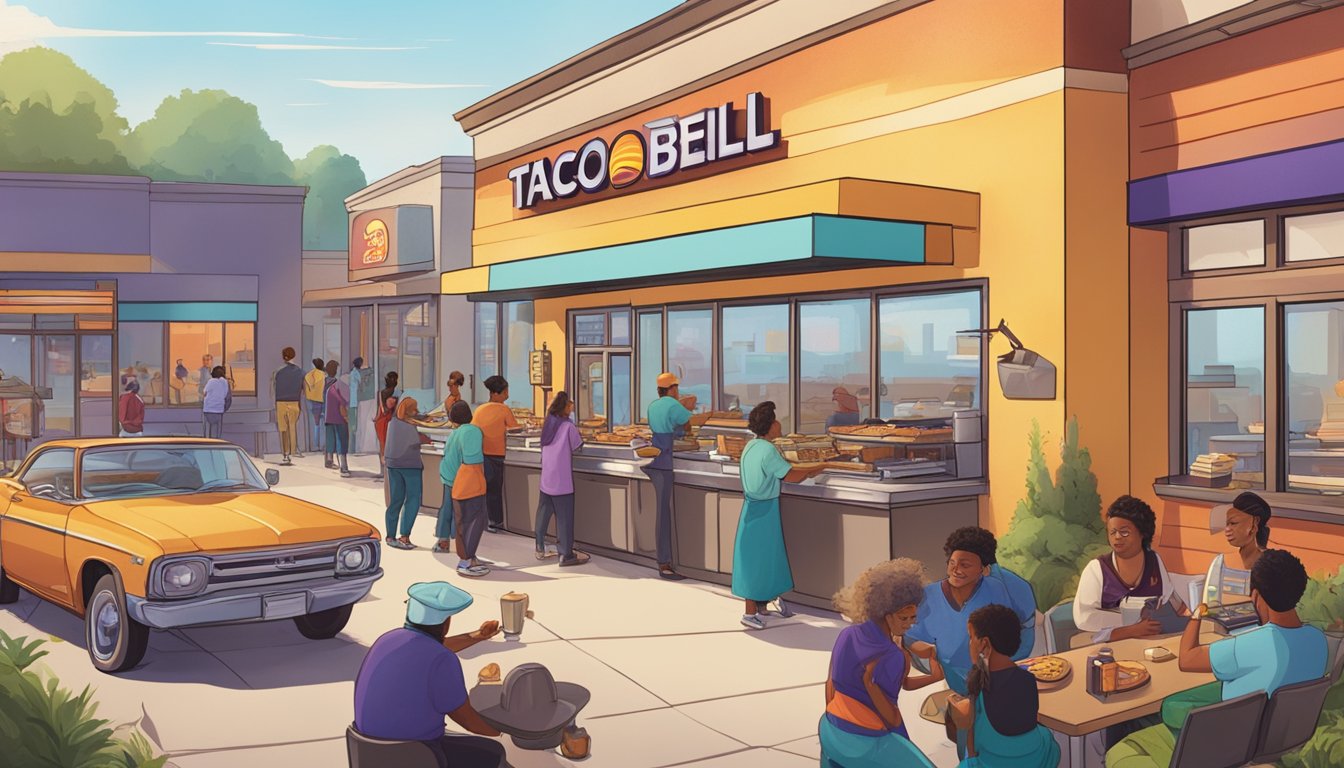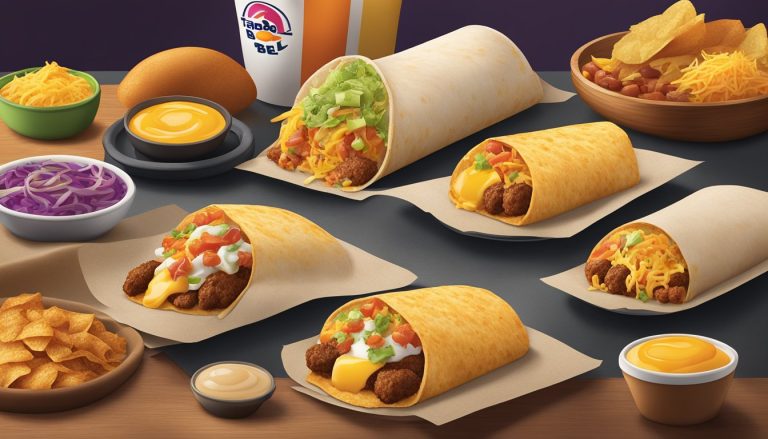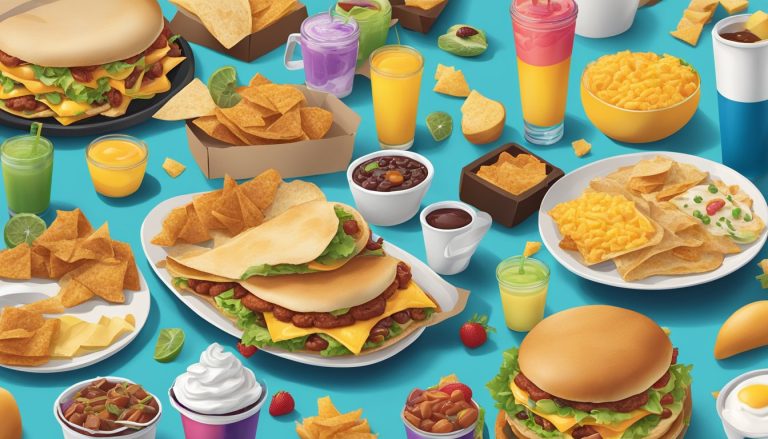Taco Bell, the beloved fast-food chain known for its Mexican-inspired cuisine, made a bold move into the breakfast market on March 27, 2014. This launch marked a significant shift in the fast-food landscape, introducing unique morning offerings like the Waffle Taco and Breakfast Crunchwrap to hungry customers across the United States.
The journey to Taco Bell’s breakfast menu began long before its nationwide rollout. The California-based company, founded in 1962 by Glen Bell, had been experimenting with breakfast items in select locations for years. These early trials allowed the chain to refine its menu and gauge customer interest before committing to a full-scale launch.
Taco Bell’s entry into the breakfast arena was met with both excitement and skepticism. The chain’s innovative approach to morning meals, blending traditional breakfast ingredients with its signature Tex-Mex flavors, set it apart from competitors. This unique offering helped Taco Bell carve out its own niche in the highly competitive fast-food breakfast market.
The Inception of Taco Bell
Taco Bell’s origins trace back to the entrepreneurial spirit of Glen Bell in post-World War II Southern California. Bell’s journey from hot dog stands to Mexican-inspired fast food laid the groundwork for a global brand.
Glen Bell’s Early Ventures
Glen Bell entered the food industry in 1948 with a hot dog stand in San Bernardino, California. He soon noticed the popularity of a nearby Mexican restaurant, Mitla Cafe. Intrigued by their success, Bell befriended the owners and learned their taco-making techniques.
In 1951, Bell opened his first Taco Stand. The concept was novel – tacos served quickly in a take-out setting. His stand gained popularity, prompting Bell to open more locations. He experimented with different names and menu items, including a restaurant called El Taco in 1958.
The Foundation of the Taco Bell Brand
Bell’s culinary experiments culminated in the first Taco Bell, opened in Downey, California in 1962. The restaurant featured a distinctive mission-style architecture and a simple menu of just five items: tacos, burritos, frijoles, chiliburgers, and tostadas.
The original menu was priced affordably, with tacos costing just 19 cents. This strategy helped Taco Bell quickly gain a loyal customer base. By 1964, Bell had opened his first franchise location, setting the stage for rapid expansion.
Taco Bell’s unique blend of Mexican-inspired flavors and American fast-food efficiency resonated with customers. The brand’s growth in the 1960s and 1970s established it as a major player in the fast-food industry.
Innovation and Menu Development

Taco Bell’s journey from a small hot dog stand to a global fast-food giant is marked by bold innovations and unique menu offerings. The brand’s willingness to experiment with flavors and formats has set it apart in the competitive fast-food landscape.
From Hamburgers to Mexican Cuisine
Glen Bell, Taco Bell’s founder, started with hot dogs and hamburgers in the 1940s. He soon noticed the popularity of a nearby Mexican restaurant and decided to create his own version of hard-shell tacos. Bell’s innovation was to pre-fry the tortilla shells, allowing for faster assembly. This breakthrough led to the opening of the first Taco Bell in 1962 in Downey, California.
The menu initially featured tacos, burritos, frijoles, chiliburgers, and tostadas. As Taco Bell expanded, it continued to adapt traditional Mexican dishes for the American palate. This fusion approach became a cornerstone of the brand’s identity.
Introduction of Signature Items
Taco Bell’s menu evolution accelerated in the 1980s and 1990s with the introduction of several iconic items. The Mexican Pizza, launched in 1988, quickly became a fan favorite. It featured two crispy tortillas layered with beans, pizza sauce, seasoned beef, and melted cheese.
In 2005, Taco Bell unveiled the Crunchwrap Supreme. This innovative item wrapped a tostada shell, seasoned beef, nacho cheese sauce, lettuce, tomatoes, and sour cream in a grilled, hexagonal tortilla. The Crunchwrap’s unique format and portability made it an instant hit.
The Doritos Locos Tacos, introduced in 2012, represented a groundbreaking collaboration between Taco Bell and Frito-Lay. This fusion of a hard-shell taco with Doritos flavoring became one of the most successful product launches in fast-food history.
Expansion and Franchising

Taco Bell’s growth strategy leveraged franchising and strategic partnerships to rapidly expand its footprint across the United States and globally. This approach allowed the brand to scale quickly while maintaining quality and consistency.
Growth of Taco Bell Locations
Taco Bell’s expansion began in the 1960s, fueled by the franchising model. By 1970, the chain had grown to 325 restaurants. The 1980s saw explosive growth, with Taco Bell reaching 1,000 locations by 1986.
Franchisees played a crucial role in this expansion. They invested capital and local expertise, enabling Taco Bell to enter new markets rapidly. The company provided franchisees with a proven business model, brand recognition, and operational support.
International expansion commenced in the late 1980s. Taco Bell opened its first international location in Canada in 1988. By the 1990s, the chain had established a presence in countries like the United Kingdom, Japan, and Australia.
Partnerships and Acquisitions
PepsiCo’s acquisition of Taco Bell in 1978 marked a significant turning point. This partnership provided Taco Bell with substantial financial resources and distribution networks to accelerate growth.
In 1997, PepsiCo spun off its restaurant division, creating Tricon Global Restaurants (later renamed Yum! Brands). This move grouped Taco Bell with other fast-food giants like KFC and Pizza Hut.
Taco Bell formed strategic partnerships to expand its reach. Co-branding with KFC and Pizza Hut allowed the chain to enter new locations and share operational costs. The company also partnered with franchisees to develop new restaurant designs and concepts, adapting to changing consumer preferences.
Marketing and Cultural Impact
Taco Bell’s breakfast launch was supported by innovative marketing campaigns and quickly became part of pop culture. The brand’s creative ads and promotions helped establish its unique position in the fast food breakfast market.
Promotional Campaigns
Taco Bell invested heavily in marketing to promote its breakfast menu. The company launched its largest advertising campaign ever, featuring catchy slogans and eye-catching visuals. TV commercials showcased the new menu items, emphasizing their uniqueness compared to traditional breakfast offerings.
Social media played a crucial role in spreading awareness. Taco Bell leveraged platforms like Twitter and Instagram to engage customers and create buzz. The brand also partnered with influencers to reach younger demographics.
Limited-time offers and promotions encouraged customers to try the new breakfast items. Free breakfast giveaways on specific dates helped drive traffic and word-of-mouth marketing.
Taco Bell in Popular Culture
The breakfast launch further cemented Taco Bell’s place in American pop culture. Late-night talk shows and comedy sketches often referenced the chain’s move into the breakfast space.
The iconic Taco Bell Chihuahua, voiced by Gidget, made a brief comeback in some breakfast-related ads. This nostalgic touch resonated with long-time fans of the brand.
Taco Bell’s “Steal a Base, Steal a Taco” promotion during the World Series expanded to include breakfast items, linking the brand to major sporting events.
The renaming of Boise State University’s arena to Taco Bell Arena in 2004 showcased the brand’s growing influence beyond just food.
Innovative Collaborations

Taco Bell’s breakfast launch involved strategic partnerships to create unique offerings and reach new customer segments. These collaborations helped differentiate the chain’s morning menu from competitors.
Leveraging Partnerships
Taco Bell partnered with PepsiCo to introduce Mountain Dew Baja Blast as a breakfast beverage option. This tropical lime-flavored soda, previously only available at Taco Bell locations, became a popular choice for morning diners seeking a caffeinated alternative to coffee.
The fast food chain also collaborated with major sports teams to promote its breakfast menu. A notable partnership was with the Boston Red Sox, which included special promotions and themed menu items at Fenway Park.
Engaging New Audiences
To attract tech-savvy customers, Taco Bell explored innovative partnerships in the digital space. The company experimented with using Starlink satellite internet to provide free Wi-Fi at select locations, enhancing the breakfast experience for customers who enjoy browsing while eating.
Taco Bell’s breakfast marketing campaigns often featured unexpected collaborations. One such partnership involved a tie-in with the Mir Space Station, creating buzz around “out-of-this-world” breakfast options and appealing to space enthusiasts.
These creative collaborations helped Taco Bell’s breakfast menu stand out in a crowded market and attract diverse customer groups.
Product Development & Breakfast Menu

Taco Bell’s foray into breakfast revolutionized fast-food morning offerings. The company developed unique items that blended Mexican-inspired flavors with traditional breakfast fare.
Expanding the Taco Bell Menu
Taco Bell began exploring breakfast options in the early 2010s. The company aimed to differentiate itself from competitors by creating innovative menu items. They focused on portable, handheld foods that could be eaten on-the-go.
Taste tests and market research helped refine potential offerings. The development team experimented with various combinations of eggs, cheese, meats, and tortillas. They also created sweet options to appeal to a broader customer base.
The Launch of Breakfast Options
Taco Bell officially launched its breakfast menu on March 27, 2014. The initial lineup included several standout items:
- Waffle Taco: A waffle wrapped around scrambled eggs and sausage or bacon
- A.M. Crunchwrap: A tortilla filled with eggs, hash browns, cheese, and meat
- Breakfast Burrito: A classic offering with eggs, cheese, and choice of meat
- Cinnabon Delights: Bite-sized pastries filled with cream cheese frosting
The menu also featured coffee and orange juice to complement the food items. Taco Bell’s breakfast was initially available from 7 a.m. to 11 a.m. at participating locations.
Customer response to the new breakfast options was generally positive. The unique items, particularly the Waffle Taco and A.M. Crunchwrap, generated significant buzz on social media and in the press.
Consumer Experience & Service

Taco Bell’s breakfast launch transformed the fast food morning landscape. The chain adapted its service model and focused on customer satisfaction to establish itself as a competitive breakfast option.
Service Model Evolution
Taco Bell leveraged its existing Drive-Thru Service to accommodate breakfast customers. The chain optimized its kitchen operations to handle both breakfast and regular menu items efficiently. Many Taco Bell Locations extended their hours, opening earlier to serve the morning crowd.
The breakfast menu was designed for quick preparation and easy eating on-the-go. Items like the A.M. Crunchwrap were portable and mess-free, catering to busy commuters. Taco Bell also introduced a breakfast Value Menu, offering affordable options to attract price-conscious consumers.
Customer Satisfaction and Feedback
Initial customer response to Taco Bell’s breakfast was mixed. Some praised the innovative menu items, while others found them too unconventional for breakfast. The chain actively sought customer feedback and made menu adjustments accordingly.
Taco Bell conducted surveys and analyzed sales data to refine its breakfast offerings. Popular items like the Breakfast Crunchwrap became staples, while less successful options were phased out. The company also invested in employee training to ensure consistent quality and service during breakfast hours.
Customer satisfaction improved over time as Taco Bell fine-tuned its breakfast menu and operations. The chain’s willingness to experiment and adapt helped it carve out a unique niche in the competitive fast food breakfast market.
Legacy and Brand Evolution

Taco Bell’s journey from a single restaurant to a global fast food empire is marked by innovative branding and menu adaptations. The company’s ability to evolve while maintaining its core identity has been key to its enduring success.
Building a Fast Food Empire
Glen William Bell Jr. laid the foundation for Taco Bell’s expansive reach. Starting with a single location in 1962, the chain rapidly grew to 100 restaurants by 1970. Bell’s vision of quick-service Mexican-inspired food resonated with American consumers. The company’s distinctive branding, featuring the iconic bell logo, became synonymous with affordable, convenient meals. Taco Bell’s seasoning and sauce recipes, developed to appeal to American palates, played a crucial role in its popularity. By 1978, the chain had 868 restaurants. This rapid expansion solidified Taco Bell’s position as a major player in the fast food industry.
Adapting to Changing Tastes
Taco Bell has consistently updated its menu to meet evolving consumer preferences. The introduction of the Americanized “Mission-style” burrito in 1988 marked a significant shift. In 2012, the company launched the Doritos Locos Tacos, selling over 1 billion units within two years. Taco Bell has also embraced healthier options, introducing the Fresco menu in 2005. The chain’s venture into breakfast in 2014 with items like the Waffle Taco demonstrated its willingness to challenge industry norms. These adaptations have helped Taco Bell maintain relevance in a competitive market. The brand’s ability to blend innovation with its established identity has ensured its continued growth and customer loyalty.




